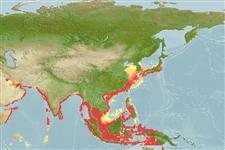Classificação / Names
Common names from other countries
Referência principal
Tamanho / Peso / Idade
Max length : 60.0 cm SL macho/indeterminado; (Ref. 9811); common length : 30.0 cm SL macho/indeterminado; (Ref. 9811)
Length at first maturity
Lm ?, range 18 - ? cm
Ambiente
; marinhas bentopelágico; oceanódromo (Ref. 51243); intervalo de profundidade 5 - 110 m (Ref. 12260)
Clima / Intervalo
Subtropical, preferred 25°C (Ref. 107945); 46°N - 10°S, 47°E - 142°E
Distribuição
Indo-West Pacific: Persian Gulf to Indonesia, north to Hokkaido, Japan. Extralimital captures have been made from the Adriatic and off Hawaii. Not recorded from Australasia. Northeastern Atlantic: 3 reports of capture reported from this area (Ref. 86350).
Países | Áreas FAO | Ecossistemas | Ocorrências | Introduções
Descrição breve
Espinhos dorsais (total): 0; Raios dorsais moles (total): 37-43; Vértebras: 34 - 37. Body firm, very deep, oval, and compressed. Operculum absent; gill opening reduced to a vertical slit on the side of the body; gill membrane broadly united to isthmus. Dorsal and anal fins preceded by a series of 5 to 10 blade-like spines with anterior and posterior points. Pelvic fins absent. Caudal fin deeply forked, the lower lobe longer than the upper. Color is gray above grading to silvery white towards the belly, with small black dots all over the body. Fins are faintly yellow; vertical fins with dark edges.
Categoria na Lista Vermelha da IUCN (Ref. 115185)
Ameaça para o homem
Harmless
Utilização humana
Pescarias: altamente comercial
Ferramentas
Relatórios especiais
Descarregue XML
Fontes da internet
Estimates of some properties based on models
Phylogenetic diversity index
PD50 = 0.5313 many relatives (e.g. carps) 0.5 - 2.0 few relatives (e.g. lungfishes)
Nível Trófico
3.3 ±0.1 se; Based on diet studies.
Resiliência
Médio, tempo mínimo de duplicação da população 1,4 - 4,4 anos (K=0.24-0.26; tmax=7)
Vulnerabilidade
Low to moderate vulnerability (33 of 100)
Categoria de preço
